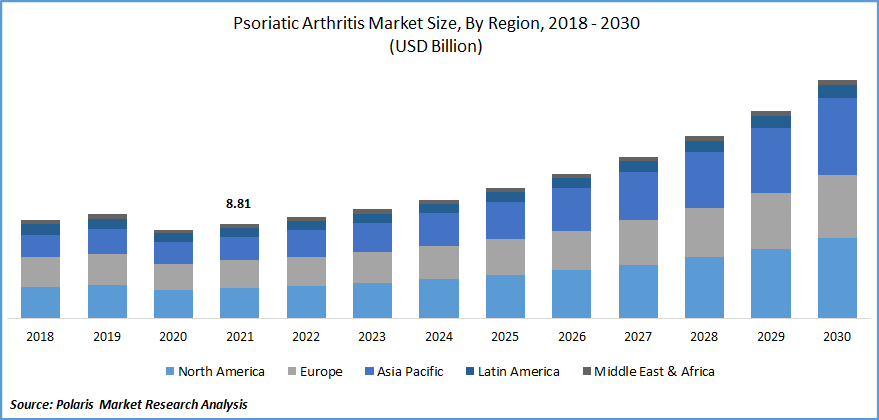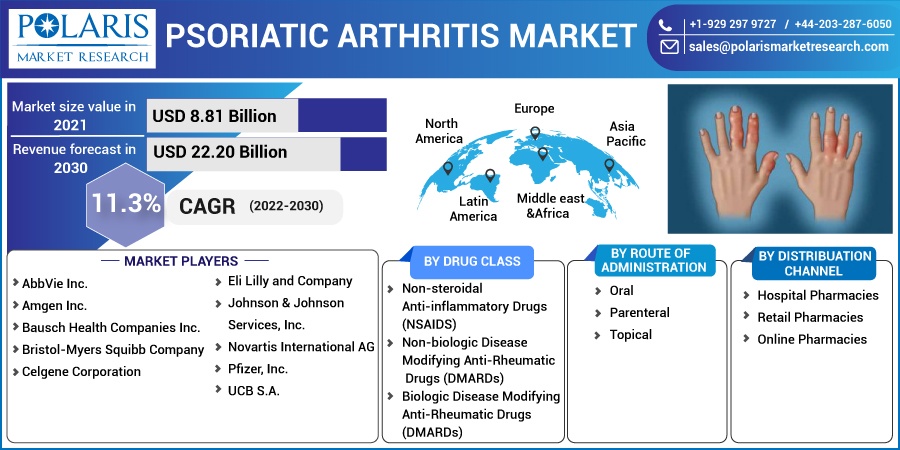
Psoriatic Arthritis Market Share, Size, Trends, Industry Analysis Report, By Route of Administration (Oral, Parenteral, Topical); By Drugs Class; By Distribution Channel; By Region; Segment Forecast, 2022 - 2030
- Published Date:Oct-2022
- Pages: 114
- Format: PDF
- Report ID: PM1346
- Base Year: 2021
- Historical Data: 2018-2020
Report Outlook
The global psoriatic arthritis market was valued at USD 8.81 billion in 2021 and is expected to grow at a CAGR of 11.3% during the forecast period. Psoriatic arthritis is a type of spondyloarthritis that affects the joints and is linked to the skin condition psoriasis. It has an impact on the musculoskeletal system and the skin. Environmental and genetic factors together are the cause. Its symptoms include stiffness, pitted nails, swollen toes, fingers, and painful joints, as well as lower back pain.

Know more about this report: Request for sample pages
Obesity and overweight are characterized as excessive or irregular fat accumulations that can harm one's health. In 2016, around 1.9 billion individuals aged 18 and up were overweight. Over 650 million of those individuals were obese. In 2016, 39% of individuals aged 18 and up were overweight, and 13% were obese.
In 2020, 39 million kids under the age of five were overweight or obese. In 2016, nearly 340 million kids and adolescents aged 5 to 19 were considered overweight or obese. Consequently, it is anticipated that the risk of psoriatic arthritis will rise as the incidence of obesity grows.
Furthermore, unhealthy lifestyle choices such as excessive smoking and alcohol consumption are risk factors for the development of psoriatic arthritis. Furthermore, the development of novel therapeutic techniques is expected to propel the market's growth. Its prevalence has been steadily increasing over the past few years, which has been linked to aging populations, stressful lifestyles, genetic alterations, and rising life expectancy.
Other significant factors that are anticipated to contribute to the global market revenue growth include the rising prevalence of immune system disorders brought on by unhealthy and stressful lifestyles and the development of advanced biologics and biosimilars for safer and more effective treatment.
The COVID-19 pandemic has changed the way that patients who need frequent interaction with medical facilities are treated. Patients with psoriatic arthritis are using telehealth services and online pharmacy solutions more frequently to obtain their prescriptions and meds delivered at home. Additionally, the co-morbidities that are present in psoriatic patients include heart conditions, diabetes, stress, anxiety, and other psychological illnesses.
Current research focuses on preventing PsA patients from using immunosuppressant medications during the COVID-19 pandemic. The COVID-19 pandemic had a negligible effect on the psoriatic arthritis market medications. Despite the dermatologists being unavailable due to the lockdown, the telehealth services provided by the healthcare facilities are helping to support the PsA patients.

Know more about this report: Request for sample pages
Industry Dynamics
Growth Drivers
Psoriatic arthritis prevalence has been steadily increasing over the past few years, which has been linked to aging populations, stressful lifestyles, genetic alterations, and rising life expectancy. According to the National Psoriasis Foundation, Psoriasis and psoriatic arthritis affect millions of individuals in the United States and throughout the world.
According to current research, more than 8 million individuals in the United States have psoriasis. According to the World Psoriasis Day initiative, 125 million individuals worldwide 2 to 3% of the entire population have psoriasis. It affects around 30% of patients with psoriasis.
Furthermore, Psoriasis affects 1.5 percent of African Americans as opposed to 3.6 percent of Caucasians. Psoriasis can emerge at any age. However, it usually appears in two stages. The first is between the ages of 20 and 30, and the other is between the ages of 50 and 60. It typically appears between the ages of 30 and 50; however, it can appear at any age. Therefore, it is anticipated that the market will develop more rapidly during the projection period due to the steadily increasing patient population.
Report Segmentation
The market is primarily segmented based on drug class, route of administration, distribution channel, and region.
|
By Drug Class |
By Route Of Administration |
By Distribuation Channel |
By Region |
|
|
|
|
Know more about this report: Request for sample pages
The Parenteral Segment is Expected to Witness the Fastest Market Growth
In terms of mode of delivery, the parenteral route generated the fastest revenue share for the treatment of psoriatic arthritis. Biological medications are intended to be taken systemically. Drugs are instantly concentrated in the blood when administered by parenteral or systemic routes, avoiding the first-pass effect.
The domination of the market is attributed to the benefits of the systemic route, the high cost of injectable medications, and the rising use of cutting-edge therapies for the treatment of disease. Due to an increase in product launches in the biologics category, the segment is anticipated to maintain its top spot during the projected period.
In terms of the method of administration, injectables dominated the psoriatic arthritis market. The anticipated launches of biologics and biosimilars are expected to fuel the segment's rapid growth during the forecast period. Subcutaneous or intravenous injections are used to administer biologics most frequently.
Biologics & Dmards Sector is Expected to Hold the Significant Market Revenue Share
The development of novel therapies in the psoriatic arthritis treatment market is being pushed by a research-driven understanding of the pathophysiology of the condition. This is inspiring new ideas among market players, promoting the expansion of the psoriatic arthritis treatment market. Targeted biological therapy continues to hold a desirable position in the psoriatic arthritis market since it has been showing a respectable success rate in causing transient pain reduction.
According to the analysis, demand for DMARDs accounts for more than 3/4 of the market's overall value. Although the majority of psoriatic arthritis patients choose injectables as their preferred method of treatment administration, the growing availability of cutting-edge oral medications is enhancing the appeal of orally delivered therapy.
The Demand in North America is Expected to Witness Significant Market Growth
The North American psoriatic arthritis market is anticipated to rise throughout the projected period due to an increase in the number of medications getting regulatory body approval. The growing prevalence of psoriatic arthritis, rising rates of rheumatoid arthritis, the development of advanced biologics and biosimilars for better psoriatic arthritis management, and the presence of major market players in the area are all contributing factors.
As per the National Psoriasis Foundation, One in every 3 persons with psoriasis has a psoriasis-afflicted family. If one parent has psoriasis, the child has a 10% risk of having it as well. Even when both parents have psoriasis, the child has a 50% chance of contracting the disease. Patients with psoriasis have much higher annual healthcare costs than just the overall population, which might total $135 billion (2013 US dollars). The financial strain of psoriasis in the United States is significant since the condition has significant negative physical, mental, and social repercussions.
Additionally, it has been shown that PsA patients in Asia have significant rates of subclinical atherosclerosis and conventional cardiovascular risk factors. TNF inhibitors may be used to treat PsA atherosclerosis, according to preliminary findings.
For quantifying the PsA burden among Chinese people, several outcome measurement tools, such as the Medical Outcomes Survey Form and the Health Assessment Questionnaire, were analyzed. The Asia Pacific League of Associations for Rheumatology (APLAR) and the Group for Research and Assessment of Psoriasis and Psoriatic Arthritis (GRAPPA) are working together to evaluate the disease burden and disease behaviour.
Competitive Insight
Some of the major players operating in the global market include AbbVie Inc., AstraZeneca PLC, Amgen Inc., Bausch Health Companies Inc., Bristol-Myers Squibb Company, Celgene Corp., Eli Lilly and Company, Johnson & Johnson Services, Inc., Novartis International AG, Pfizer, Inc., and UCB S.A.
Recent Developments
- In June 2021, AbbVie revealed that the Department Of Health has authorized RINVOQ (upadacitinib, 15 mg), a sublingual, once-daily preferential, and reversible JAK antagonist, for the use of adults with energetic psoriatic arthritis (PsA) who have had an individual’s response or prejudice to methimazole or other Disease-Modifying Anti-Rheumatic Drugs (DMARDs).
- In August 2019, Can-Fite declared an agreement with the Kyongbo Pharm., to distribute Can-lead Fite's candidate, Piclidenoson, to PsA patients in South Korea.
Psoriatic Arthritis Market Report Scope
|
Report Attributes |
Details |
|
Market size value in 2021 |
USD 8.81 billion |
|
Revenue forecast in 2030 |
USD 22.20 billion |
|
CAGR |
11.3% from 2022 - 2030 |
|
Base year |
2021 |
|
Historical data |
2018 - 2020 |
|
Forecast period |
2022 - 2030 |
|
Quantitative units |
Revenue in USD billion and CAGR from 2022 to 2030 |
|
Segments Covered |
By Drug Class, By Route of Administration, By Distribution Channel, By Region |
|
Regional scope |
North America, Europe, Asia Pacific, Latin America, Middle East & Africa |
|
Key Companies |
AbbVie Inc., Amgen Inc., Bausch Health Companies Inc., Bristol-Myers Squibb Company, Celgene Corporation, Eli Lilly and Company, Johnson & Johnson Services, Inc., Novartis International AG, Pfizer, Inc., and UCB S.A. |
